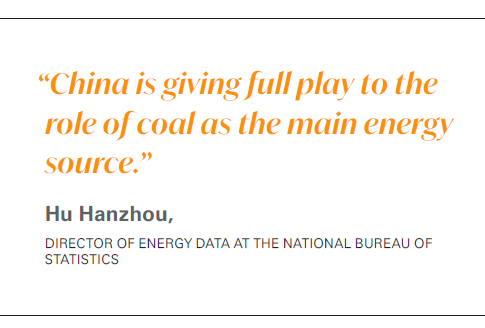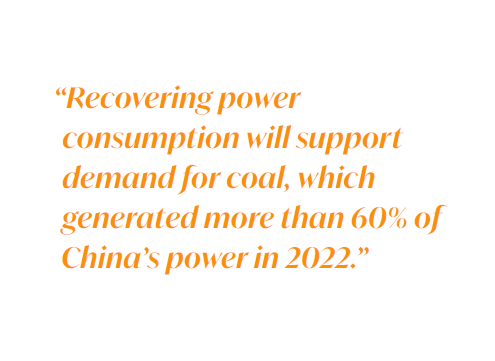Coal stays king in China [Gas in Transition]
Coal power generation in China looks set to extend last year’s strong momentum into 2023, as the Chinese government prioritises energy security and economic stability in the short term, but gas-fired power generation will benefit from falling international gas prices will help gas-fired power.
Chastened by high-profile power blackouts over the past two years, Chinese authorities have focused on shoring up short-term energy supply security at the expense of decarbonisation and the energy transition. China’s energy policy has increasingly shifted towards replacing imported oil and gas with domestic thermal coal, still the dominant fuel source in China and the only fossil fuel to expand its share of the national energy mix last year.
Coal accounted for 56.2% of Chinese primary energy consumption in 2022, up from 56.0% in 2021, according to official statistics. The increase came at the expense of the market shares for oil and natural gas, which declined by a respective 0.6 and 0.4 percentage points to 17.9% and 8.5%. Non-fossil fuels including renewables, hydro and nuclear advanced their share of the market to 17.4% of the energy mix.
China’s coal consumption increased by 4.3% last year, marking the first time in almost two decades that coal use grew faster than GDP – although analysts have argued this increase is difficult to reconcile with decreases last year in the output of coal-fired power generation, steel and cement. Chinese coal demand mostly goes to power generation and heating, which made up 71% of demand last year, according to data from information provider Wind.
Coal will likely continue as China’s dominant power source until at least the next three to five years, by which time the country should be close to peaking its carbon emissions. Coal presents the easiest path to energy security based on vast domestic coal reserves and the fossil fuel remains the most affordable option for baseload power.
China’s strategy is to leverage its “national conditions” of being rich in coal and give “full play to the role of coal as the main energy source,” said Hu Hanzhou, director of energy data at the National Bureau of Statistics, recently.
Post-pandemic recovery
China’s economy is poised to rebound this year, with President Xi Jinping’s new administration in March setting a relatively conservative GDP growth target of 5.0% compared with 3.0% in 2022. China’s historical GDP growth has a track record of outpacing government forecasts – in 12 of the past 18 years growth has exceeded the official target. This is likely another case of under-promising and over-delivering.
Wood Mackenzie’s base case is for China’s economy to grow by 5.5% this year, which will increase domestic coal demand in the power sector by 85mn metric tons and in the non-power sector by 17mn mt. But in a high-growth scenario where the economy expands by 7%, China’s coal demand could conceivably reach 158mn mt for power and 56mn mt for non-power, according to the energy consultancy.
Recovering power consumption will support coal demand. The fuel backed more than 60% of the country’s power generation in 2022. While the country is moving toward decarbonisation with increased use of renewable energy, coal will continue as the key baseload power source for the next five to six years at least.
Power consumption in January and February increased by 2.3% year-on-year to 1,383.4 GWh. This was slower than last year’s overall growth of 3.6%, but explained by China’s chaotic exit from its zero-COVID policy at the end of last year and then the weeklong Lunar New Year public holiday in late January. Power consumption growth is anticipated to rebound to around 6% this year, according to a forecast from the China Electricity Council, the power sector’s top lobbying group.
Coal demand from other industries should be stable in 2023. Central authorities have rolled out a batch of policies supporting the property sector, which is plausibly on track to recover in the second half of this year. This would lift coal demand for correlated industries, such as cement and steel manufacturing, which rely on coal as an energy source. But sluggish demand in the US and the eurozone may hit Chinese manufacturing this year.
Policy steps guarantee supply
The Chinese government’s focus on energy security means supply tightness in the domestic coal market will continue to ease. Domestic coal output in 2023 surged by 10.5% year-on-year to 4.56bn mt – the biggest annual increase since China introduced supply-side reforms to the coal sector in 2016 – and production is likely to continue its upward trajectory in 2023 on the back of supportive government policies.
The expected ramp-up in coal production will flow from last year’s targeted capacity addition of 300mn mt/yr. This combined with likely higher energy demand post-pandemic, will push coal miners to raise output this year. But growth will probably moderate from last year’s 10% expansion, particularly as stricter and more extensive safety inspections on coal mines prompted by a recent fatal coal mine collapse in Inner Mongolia could impede the trend for supply easing.
 Given energy security is at the top of Beijing’s agenda, the National Development and Reform Commission (NDRC) – China’s national economic planner – has taken steps to better ensure fuel supply to coal-fired power plants. This was achieved through adjustments to a price cap and medium- to long-term contracts in the Chinese coal market last year.
Given energy security is at the top of Beijing’s agenda, the National Development and Reform Commission (NDRC) – China’s national economic planner – has taken steps to better ensure fuel supply to coal-fired power plants. This was achieved through adjustments to a price cap and medium- to long-term contracts in the Chinese coal market last year.
In May 2022 the NDRC implemented a “reasonable” reference price range of RMB 570-770/mt ($83-112/mt) for coal with an energy content of 5,500 kilocalories sold under medium- and long-term contracts, defined as those lasting more than one year. The system includes a base price plus a floating range that is adjusted monthly based on the weighted average of coal price indexes. The base price for the 2022 term contract was set at RMB 700/mt. Then in November the NDRC set the 2023 base price at RMB 675/mt, thereby serving notice to coal mining companies that the price limit would be maintained.
The NDRC’s second change was to the medium- to long-term contracts covering coal miners, coal-fired power and heating suppliers. In November the NDRC instructed all coal miners to sell to power and heating suppliers under medium- and long-term contracts, calling for sales under such contracts to rise to 2.9bn mt in 2023 from 2.6bn mt in 2022. Previously, this order only covered coal miners that produced more than 300,000 mt/yr.
The NDRC also said coal mines should put at least 80% of their overall output and 75% of their thermal coal output under the long-term contracts.
Limits to coal growth
China’s coal reliance is set to increase for the foreseeable future, but there is still room for other fuel sources to grow. The decline in the benchmark Japan-Korea Marker from a high of $69/mn Btu last August to below $13/mn Btu this month means gas is now competitive with coal for Asian power generators.
China’s installed gas-to-power generation capacity stood at 120 GW at the end of February, up by 6.7% from a year ago. Gas-fired generation hit seasonal record highs last summer due to an extended heat wave and accompanying drought that engulfed most of central and eastern China in July and August, and it would not be unusual to see a repeat this year as such extreme weather events will occur more frequently according to current climate science.
China has experienced severe power crunches in the past two summers that were caused by myriad factors. Shortages in 2021 were blamed on a power supply-demand imbalance caused by a perfect storm of booming electricity demand, high coal prices and the central government’s carbon neutrality objectives, while severe drought caused last summer’s painful blackouts in hydropower-dependent southwest China.
These events spurred China last year to permit the most new coal-fired power capacity since 2015, at 106 GW, global energy research groups said in early March. This was more than six times the amount of coal power permitted in 2022 across the rest of the world.
But the massive additions of new coal-fired capacity do not necessarily mean that coal combustion will increase in China. Chinese power dispatch laws mandate that solar, wind and hydro should be dispatched to the grid first before coal-fired power, meaning coal-fired power is supposed to only be used when it is needed – that is, when all cheaper and cleaner sources of generation have been exhausted or are already unavailable.
Considering China is expected to continue adding record levels of renewable energy capacity, it is reasonable to assume new coal plants will see low usage rates of 30-40% or even lower once they finish. China is expected to add 160 GW of solar and wind power capacity this year.
Such unattractive forecasts mean many plant owners are likely to abandon their construction plans going forward. Even provinces that have historically favoured dispatching local coal over imported renewables will see increased pressure to reform these habits, in view of ever-increasing renewable power consumption quotas.



